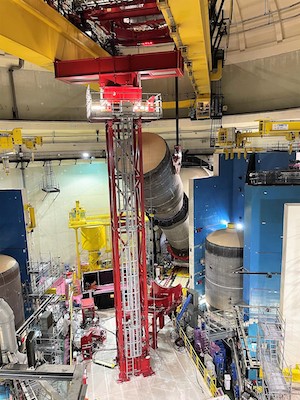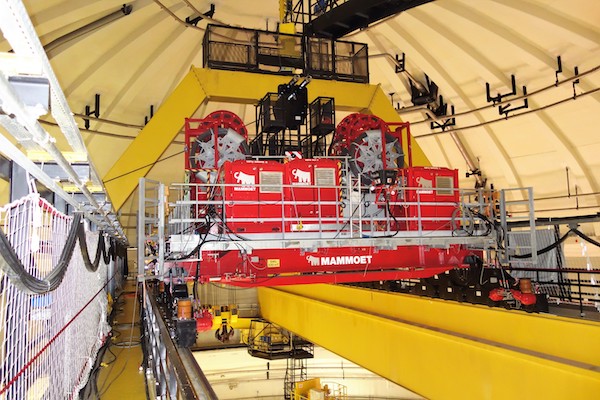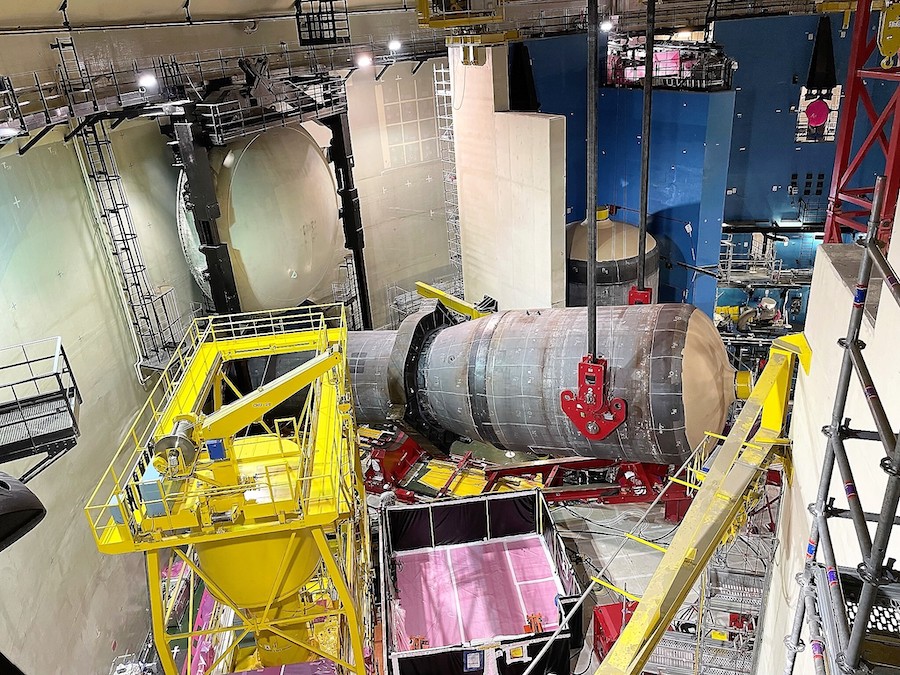Five years ago Mammoet was approached by Framatome to assist with the removal and replacement of four steam generators from inside its nuclear power plants in France.
The main challenge of this project, led by a combination of Mammoet experts from France and from its main engineering offices in Schiedam, the Netherlands, was taking these generators out safely in one piece, which was necessary because of possible contamination.
The tasks of Mammoet were to design a method to safely lift each of the large and heavy steam generators from their cubicles; and carefully rotate and maneuver the steam generators into a position so that they could be skidded outside the reactor building for decommissioning. This equipment was sizeable, at 25m long, 6.5m in diameter, and 520t per unit. The main piece of equipment used for servicing and replacing parts inside a nuclear reactor building is the polar crane. However, because the steam generators could not be lifted by the polar crane alone, a specialist set of handling equipment had to be produced.

Olivier Vanesse, nuclear activities manager and Project Director from Mammoet France, explains: “The facilities and infrastructures inside the reactor buildings are such that you cannot simply make a basic tailing operation. You need to be able to steer the steam generator, you need it to rotate. There are a number of steps that need to happen in order to move each of them through the main hatch. So that’s a difficult operation.”
“The lifting and tailing operation for 1300MW nuclear units is very complex. This is due to the fact that each steam generator weighs 520 tonnes, and this is more than the capacity of the polar crane, which has been designed for the placing of each steam generator in two parts at the construction stage. Therefore, you need to use a support in the middle of the polar crane to ensure that during the tailing process it has enough capacity – constraints and deflections-wise.”

As no specialist handling equipment already existed that was capable of completing the task, work commenced on designing, prototyping, manufacturing and testing a new set; ensuring that it complied with the stringent technical and regulatory rules of EDF. This set comprised four parts: a lifting trolley, installed on the polar crane, which would be used for lifting and tailing the steam generators; a supporting mast to reinforce the center of the polar crane; a device for down-ending and tailing the steam generators; and the saddles and skidding tracks used to maneuver the generators in and out of the reactor building.
An important step in helping the team to understand this, and how to approach the design of the equipment, was the production of a 3D computer-rendered model of the inside of the reactor building. From this they were able to conduct investigations during the site walkdowns, determine the tolerances, and develop the design of the equipment and site execution procedures. Olivier adds: “The 3D scans were really useful to us and very accurate. We had scans, as well as high-resolution photos, and were able to make virtual visits to take measurements and see the equipment going inside the reactor building. It was really interesting for us to have this tool at our disposal.”
The data gathered would inform the project’s site execution studies, which covered everything from the operating procedures and traceability of each step of the project, to the modifications of the polar cranes to ensure that their operation remained in accordance with French regulations. This raised levels of safety across the entire operation, as the work was rehearsed hundreds of times before any equipment ever went to site.
As a result of this project, Framatome now has a set of equipment and a method to safely and efficiently replace steam generators for this type of 1300MW unit.






